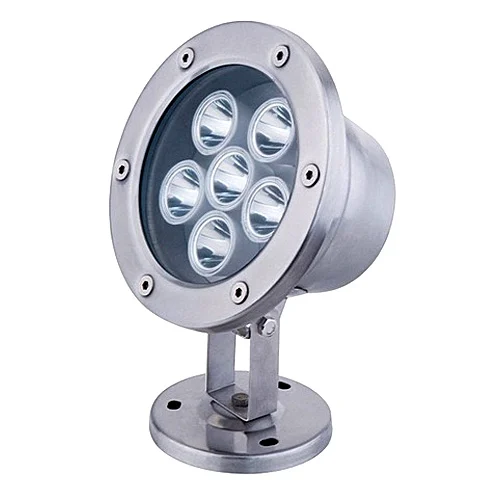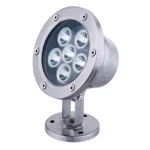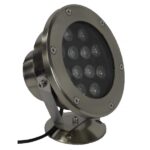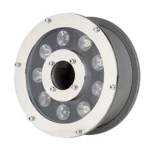

Key Features
1. Types of Underwater Lights:
- Submersible Spotlights: Focused beam lights used to highlight specific features such as fountains, waterfalls, statues, or unique underwater elements. They are often adjustable to direct light precisely.
- Pool Lights: Designed for swimming pools to provide both functional lighting for safety and decorative lighting for ambiance. They can be installed on pool walls or floors.
- Floating Lights: Portable, floating lights that provide surface-level illumination. They are often battery or solar-powered and used in ponds, pools, and fountains.
- LED Strip Lights: Flexible, waterproof LED strips that can be placed along the edges or contours of water features to create a continuous line of light.
- Color-Changing Lights: Lights that offer multiple color options or dynamic color-changing effects, often controlled by remote control or an app.
- Fiber Optic Lights: Used to create star-like effects in swimming pools or spas. They emit light without electrical connections in the water, enhancing safety.
2. Power Source:
- Low Voltage (12V or 24V DC): Common for underwater lights due to safety concerns. Requires a transformer to step down from standard line voltage.
- Solar-Powered: Lights powered by solar panels, often used for smaller installations like garden ponds or decorative fountains.
- Battery-Powered: Portable and easy to install; typically used for temporary or seasonal lighting.
3. Material and Finish:
- Materials: Common materials include stainless steel, brass, aluminum, and high-impact plastic.
- Description: Durable, corrosion-resistant materials such as marine-grade stainless steel or brass are used to withstand prolonged exposure to water, especially in saltwater environments. UV-resistant plastics are used for additional protection against sun damage.
4. Color Temperature (Kelvin):
- Range: Typically between 2700K (warm white) to 6500K (cool white), with RGB options for color-changing lights.
- Description: Warm white (2700-3000K) provides a soft, calming ambiance, while cool white (4000-6500K) offers a bright, crisp look. RGB lights provide dynamic color options for decorative effects.
5. Luminous Flux (Lumen Output):
- Range: Usually between 100 to 5,000 lumens, depending on the type and application.
- Description: The lumen output determines the brightness of the light. Lower lumens (100-300) are used for accent lighting, while higher lumens (1,000-5,000) are used for illuminating larger areas, such as pools or large fountains.
6. Beam Angle:
- Range: Typically between 15° (narrow beam) to 120° (wide beam).
- Description: Narrow beams (15°-30°) are ideal for highlighting specific objects or features, while wider beams (60°-120°) provide broader illumination for general underwater lighting.
7. IP Rating (Ingress Protection):
- Range: Typically IP68.
- Description: IP68 is the standard rating for underwater lights, indicating that they are completely dust-tight and can be submerged in water for extended periods without damage.
8. Dimming and Control Options:
- Types: Remote control, smartphone app, timers, and color-changing controllers.
- Description: Many underwater lights offer dimming capabilities and color control to create different lighting effects. Remote controls or smartphone apps provide convenient control over brightness, color, and timing.
9. Lifespan:
- Range: Typically 30,000 to 100,000 hours for LED underwater lights.
- Description: The operational life of the light source. Longer lifespans reduce maintenance and replacement costs, particularly important for lights installed in hard-to-reach locations underwater.
10. Efficiency (Lumens per Watt):
- Range: Usually between 80 to 150 lm/W.
- Description: Efficiency measures how well the underwater light converts electrical energy into visible light. Higher lumens per watt values indicate more efficient lights.
11. Safety Features:
- Features: Low voltage operation, thermal protection, waterproof connectors, and UV protection.
- Description: Safety features are essential for underwater lights to prevent electrical hazards. Low voltage operation (12V or 24V DC) is preferred, and thermal protection prevents overheating.
12. Mounting Options:
- Types: Fixed mounts, adjustable brackets, suction cups, and magnetic mounts.
- Description: Various mounting options allow flexibility in installation. Adjustable brackets enable precise positioning, while suction cups and magnets provide easy placement and repositioning for temporary setups.
13. Color Rendering Index (CRI):
- Range: Typically 70-90 or higher.
- Description: CRI measures the light’s ability to render colors accurately compared to natural light. A CRI of 70 or higher is generally sufficient for underwater applications, with higher values preferred for areas where accurate color representation is desired.
14. Remote Control & Smart Features:
- Types: Remote controls, smartphone apps, and voice control.
- Description: Some underwater lights feature remote control or smart functionality, allowing users to change colors, adjust brightness, or set timers from a distance.









